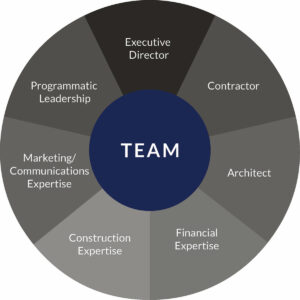This is the first article in our four-part series detailing the nonprofit building process.
The second step: Assessing the Feasibility of Your Nonprofit Building Goal
The third: Nonprofit Preconstruction Explained: Part 1
The fourth: Nonprofit Preconstruction Explained: Part 2
When beginning a nonprofit building project, the earliest and most essential step is assembling your team – both your internal committee and the external partners you’ll rely on
Internal committee
Start with your executive director and consider key leadership staff. Next, review the members of your board of directors and consider their background expertise. Identify those with financial, legal, and marketing, communications or fundraising backgrounds. Someone with a construction background could also be a valuable committee member; although conflict of interest policies may preclude them from constructing the project, they will still be able to share their expertise. Finally, review any others who support your organization and mission who might have expert knowledge or connections that may be helpful. A variety of expertise and perspectives is intrinsically valuable, but professional members can also provide checks and balances, save costs, and ensure nothing is overlooked.
External team members
Your multi-faceted committee should then seek out professional service partners to begin the preconstruction, or construction planning, process.
There are many benefits of involving a contractor early. Contractors offer budgeting throughout the design process and value engineering (devising more affordable ways to accomplish an objective). If you wait to involve a contractor until construction documents are complete, you may discover that your project is over budget and waste valuable time and funds.
It’s also important to choose the right architect for your project. The size and resources of the firm can impact fees, flexibility, and efficiencies. You’ll also want to consider the importance of industry-specific expertise. For an animal shelter project, for example, the architect may need to understand the impact of design on ease of cleaning and stress reduction for the animals.
Of course NCI-Roberts Construction would love to be your first call, and to help you select an architect. But we’re happy to join an already established partnership, as well. There are many ways to contract among team members.
CONTROLLING YOUR MESSAGE
In the early stages, it is important to maintain confidentiality among committee members and outside partners until you are ready to share the news of your project with the wider public. Obtaining signed non-disclosure agreements (also known as NDAs) from everyone with intimate knowledge of the project can keep the message under your control, allowing you to decide when, where and how to share the exciting news.
In it for the long haul
Preconstruction typically takes between four and 18 months, not including time needed for fundraising. Add to that your construction timeline, and you can see that the team you assemble will need to work well together for an extended period of time. Choosing both internal and external team members who already have or can create positive, cooperative relationships can make all the difference.
ANOTHER good place to start
If you are exploring a building project, consider downloading NCI-Roberts’ A Building Committee’s Guide to Success, featuring 14 questions to start your internal team working together. It’s also a great reference for leaders still weighing the pros and cons of taking on a building project. If you don’t have all the answers, don’t worry. A building project can feel daunting, but we are here to help. Contact our team today!
